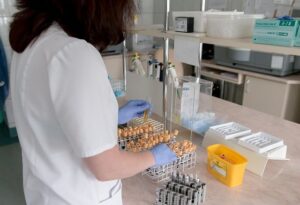Scientists Nearing Completion of Engineered Blood Vessel Design
- What are the WHO recommendations for Japanese encephalitis vaccines?
- Individuals Carrying Two APOE4 Copies Likely to Develop Alzheimer’s Disease Symptoms
- What Is The Role of Lactic Acid in Tumor Growth and Therapy Resistance?
- The Enigma of Beethoven’s Deafness: Unveiling the Role of Lead Poisoning
- World First Autologous Regenerated Islet Transplantation Successful
- FDA Approved Opdualag: The First Immunotherapy Targeting LAG-3
Scientists Nearing Completion of Engineered Blood Vessel Design
- AstraZeneca Admits for the First Time that its COVID Vaccine Has Blood Clot Side Effects
- Was COVID virus leaked from the Chinese WIV lab?
- HIV Cure Research: New Study Links Viral DNA Levels to Spontaneous Control
- FDA has mandated a top-level black box warning for all marketed CAR-T therapies
- Can people with high blood pressure eat peanuts?
- What is the difference between dopamine and dobutamine?
- How long can the patient live after heart stent surgery?
Scientists Nearing Completion of Engineered Blood Vessel Design.
Researchers at the University of Melbourne have developed a rapid, cost-effective, and scalable technique for manufacturing blood vessels from natural tissue.
Led by Associate Professor Daniel Heath and Professor Andrea O’Connor, under the Australian Research Council Future Fellow Dr. Daniel Heath and Redmond Barry Distinguished Professor Andrea O’Connor, the team employed an innovative “tissue engineering” approach to create blood vessels.

The researchers have pioneered a method of transforming natural tissue into blood vessels, a process that is faster, more cost-efficient, and scalable. This innovative method combines multiple materials and technologies to manufacture blood vessels with similarities to native vessels, offering a promising solution for treating cardiovascular diseases.
By amalgamating various materials and manufacturing techniques, they’ve devised a method to produce blood vessels with intricate geometric shapes akin to native vessels.
This research achievement was published on July 13th in the journal “ACS Applied Materials and Interfaces.” The research team also included Dr. Tao Huang, PhD students Mathew Mail and Hazem Alkazemi from the University of Melbourne, and Associate Professor Zerina Tomkins from Monash University.
Blood vessels play a vital role in sustaining life by transporting oxygen-rich blood and essential nutrients to various body parts while eliminating toxic byproducts. Conversely, vascular diseases and dysfunctions can lead to life-threatening conditions such as heart attacks, strokes, and aneurysms, making cardiovascular diseases the leading global cause of death.
Associate Professor Heath remarked that researchers worldwide have been working for years to enhance vascular tissue engineering.
He explained, “Current methods progress slowly, requiring specialized and expensive equipment like bioreactors, and exhibit low throughput, making it challenging to provide the required supply of engineered vessels. By combining multiple materials and manufacturing techniques, our approach brings us closer to engineered blood vessels becoming a transformative solution for cardiovascular diseases, especially for patients lacking suitable donor vessels.”
While bypass surgeries have proven lifesaving alternatives for severely damaged vessels, they have limitations, particularly for smaller diameter blood conduits like coronary arteries.
Non-living synthetic grafts can cause blood clotting and blockages, rendering them unsuitable in certain cases. As a result, patients with limited options due to prior surgeries or complications like diabetes face significant challenges.
To overcome these constraints, researchers have explored and developed “tissue engineering” blood vessels made from human cells and tissues. These engineered vessels hold the potential to treat cardiovascular diseases and create built-in blood supply systems for larger tissues.
Professor O’Connor noted, “This research marks an exciting stride in scientists’ capabilities for human vascular engineering, enabling us to rapidly and affordably manufacture vessels using living tissues with appropriate mechanical properties and mimicking the orientation of the innermost vessel cells.”
While these engineered blood vessels are not yet directly applicable for bypass surgeries, these findings signify significant progress in the field of tissue engineering.
Scientists Nearing Completion of Engineered Blood Vessel Design
(source:internet, reference only)
Disclaimer of medicaltrend.org
Important Note: The information provided is for informational purposes only and should not be considered as medical advice.



